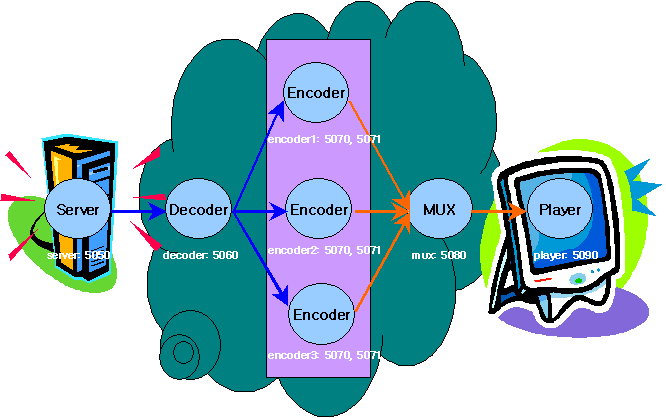An Active Subnet Transcoding System
for Rate Adaptive Video Streaming
(netAVT)
User's Guide
Internetworking and Media Communications Research Laboratories
Department of Math & Computer Science
Kent State University, 233 MSB, Kent, OH 44242
Last Revised January 31, 2001
What is a subnet transcoder?As a part of active network high performance team, in our quest for high performance active networking with the idea called subnet computing, where to meet the stringent compute cycle requirement, if a single active node is not enough then we adaptively on run time spread the computation on the neighboring active nodes to garner more computation power. This distribution contains the first version of KENT MEDIANET LAB implementation of an ISO-/IEC 13818-2 stream subnet transcoding system. The system can perform dynamic video rate adaptation, and perceptual bit-allocation. Based on our previous work on multiprocessor transcoding, we have built a three component modular transcoder. The transcoding system has the (a) GOP-Encoder (GOP-ENC), (b) decode-demultiplexer (DE-DEMUX) and (c) GOP multiplexer (GOP-MUX). Also a server and a player have been included for demonstration. The work has been funded by DARPA Research Grant F30602-99-1-0515 under it's Active Network initiative. |
How to install a parallel transcoder?You can download latest release from http://www.medianet.kent.edu. After download, use gunzip and tar command to extracts the source file. Then, change directory to s-pX-p and run make in the directory. It is tested on Redhat Linux 6.2 and 7.0, but basically you can run it any UNIX like operating systems. |
How to use a parallel
transcoder?
|
|
ServerName ServerPort PlayerName PlayerPort EncLuncher CmdPort DataPort DecoderName DecoderPort MuxName MuxPort EncLuncherNo TotalEncoderLuncherNumber EachEncoderName EachEncoderName |
![]() The ServerName and ServerPort
are the host name which will runs a server and it's port number.
The ServerName and ServerPort
are the host name which will runs a server and it's port number.
![]() The PlayerName and PlayerPort
are the host name which will runs a player and it's port number respectively.
The PlayerName and PlayerPort
are the host name which will runs a player and it's port number respectively.
![]() In EncLuncher filed, CmdPort
and Data Port are command port and data port for the encoder luncher.
In EncLuncher filed, CmdPort
and Data Port are command port and data port for the encoder luncher.
![]() The DecoderName and
DecoderPort are the host name of a decoder and a port number for it.
The DecoderName and
DecoderPort are the host name of a decoder and a port number for it.
![]() The MuxName and MuxPort are
the hostname and a port number for a multiplexer.
The MuxName and MuxPort are
the hostname and a port number for a multiplexer.
![]() TotalEncoderLuncher should be
changed to total number of encoder luncher.
TotalEncoderLuncher should be
changed to total number of encoder luncher.
![]() EachEncoderName should be
changed to a host name for each encoder.
EachEncoderName should be
changed to a host name for each encoder.
Following configuration is an example.

|
# PXNet.conf sample file server 5050 player 5090 EncLuncher 5070 5071 decoder 5060 mux 5080 EncLuncherNo 3 encoder1 encoder2 encoder3 |
Now it's ready for running a parallel transcoder.
In each machine, you run programs what you have planned in the machine.